Optimal Evacuation Strategy for Parking Lots Considering the Dynamic Background Traffic Flows
Abstract
1. Introduction
2. Literature Review
3. Materials and Methods
3.1. Assumptions
- (1)
- Each exit of the modelled parking lot connects only one road.
- (2)
- Each exit of the parking lot has one lane, which only serves one vehicle at the same time.
- (3)
- The evacuation process will not lead to traffic paralysis in the road network.
- (4)
- The vehicle traffic flows on the road network will not be disturbed by non-motor vehicles or pedestrians.
- (5)
- Vehicles evacuated from the parking lot enter into the road network only by a right turn.
3.2. Two Periods of the Evacuation Process in a Parking Lot
3.3. Queuing Modeling in the Parking Lot (the First Period)
3.4. Network Traffic Flow Modeling (the Second Period)
3.4.1. Traffic Flow Equilibrium Modeling on Nodes
3.4.2. Evacuation Traffic Equilibrium Modeling on Links
3.4.3. Travel Time on Links
3.5. Simulation of Intersection Delay under Signal Control
3.6. Optimal Evacuation Modeling
3.7. Model Solution
4. Numerical Example
4.1. Data Collection
4.2. Results
4.2.1. Optimal Evacuation Routes
4.2.2. Dynamic Evacuation Process
4.2.3. Average Queuing Time and Travel Time
5. Discussion
5.1. Optimal Evacuation Strategy
5.2. Sensitivity Analysis of
6. Conclusions
- (1)
- The simulation results of the numerical example indicate that the optimal evacuation model proposed in this research has an advantage in estimating the total evacuation time comprehensively and can generate a dynamic evacuation plan according to the time variation of background traffic flows in a road network.
- (2)
- The results also show that vehicle evacuation for the parking lot is a dynamic process. In other words, the vehicle departure rate in a parking lot has a dynamic time-variation, and the vehicles choose their optimal routes dynamically according to dynamic background traffic flows in the road network.
- (3)
- The sensitivity analysis reveals that the minimum threshold of time headway has a positive relationship with the average queuing time, a negative relationship with the average travel time, and a U-shaped relationship with the total evacuation time, which means that has a great impact on optimal evacuation plans.
Author Contributions
Funding
Conflicts of Interest
Symbols
| A | Number of vehicles in the parking lot |
| R | Number of exits of the parking lot |
| r | Index of the exit and queuing system |
| Number of vehicles in the queuing system r | |
| Average queuing time of queuing system r | |
| Average arrival rate of queuing system r | |
| Departure rate of queuing system r | |
| Background traffic volume on the road connecting rth exit | |
| Minimum threshold of time headway on the road connecting rth exit | |
| Time headway | |
| Possibility that the time headway is more than | |
| t | A time period |
| Number of intervals () during a time period t | |
| Average time between two consecutive intervals | |
| TQ | Sum of all vehicles’ queuing time in the parking lot |
| V1 | Set of origins of evacuation routes |
| V2 | Set of mid-points of evacuation routes |
| Set of destinations of evacuation routes | |
| s | Index of origins, |
| g | Index of destinations, |
| i, j | Index of nodes, |
| N | Number of mid-points in the network |
| M | Number of origins in the network |
| U | Number of destinations in the network |
| (i, j) | Index of directed links, , |
| Traffic capacity of link (i, j) | |
| Length of link (i, j) | |
| Evacuation traffic flow on link (i, j) | |
| Background traffic flow on link (i, j) | |
| Actual travel time on link (i, j) | |
| Evacuation demands from origin s to destination g | |
| Set of routes from origin s to destination g | |
| k | Index of routes, |
| Trips on route k from origin s to destination g | |
| If link (i, j) lies on the route k from origin s to destination g, , otherwise, | |
| Free flow speed on link (i, j) | |
| Coefficients | |
| Total travel time of all vehicles evacuated | |
| Average delay at the intersection j on the route (i, j) | |
| Signal cycle time | |
| Green time ratio | |
| y | Degree of saturation |
| Field calibration coefficient | |
| Total intersection delays of vehicles |
Appendix A
| Road | Road Segment | Code | Length (km) | Traffic Capacity (Vehicle/h) | Free Flow Speed (km/h) | Traffic Volume(Vehicle/Minute) | |||||||||||
|---|---|---|---|---|---|---|---|---|---|---|---|---|---|---|---|---|---|
| 13:00–13:05 | 13:05–13:10 | 13:10–13:15 | 13:15–13:20 | 13:20–13:25 | 13:25–13:30 | 13:30–13:35 | 13:35–13:40 | 13:40–13:45 | 13:45–13:50 | 13:50–13:55 | 13:55–14:00 | ||||||
| R1 | A18–C4 | 1 | 1.3 | 2400 | 80 | 46 | 47 | 49 | 49 | 50 | 51 | 51 | 48 | 48 | 49 | 47 | 50 |
| C4–C9 | 2 | 1.2 | 2400 | 80 | 45 | 47 | 48 | 50 | 52 | 48 | 47 | 49 | 50 | 51 | 53 | 51 | |
| C9–A15 | 3 | 1.2 | 2200 | 70 | 47 | 50 | 51 | 53 | 55 | 54 | 53 | 49 | 47 | 51 | 48 | 49 | |
| R2 | A2–C1 | 4 | 0.3 | 2400 | 80 | 42 | 42 | 45 | 47 | 46 | 49 | 44 | 46 | 45 | 45 | 43 | 45 |
| C1–C5 | 5 | 2.5 | 2400 | 80 | 43 | 43 | 45 | 46 | 43 | 41 | 47 | 45 | 43 | 44 | 44 | 42 | |
| C5–C10 | 6 | 1.2 | 2400 | 80 | 45 | 47 | 46 | 50 | 51 | 52 | 55 | 50 | 48 | 45 | 42 | 40 | |
| C10–C14 | 7 | 1.8 | 2200 | 70 | 42 | 44 | 43 | 45 | 46 | 45 | 45 | 46 | 43 | 42 | 40 | 41 | |
| C14–A13 | 8 | 1.1 | 2200 | 70 | 44 | 45 | 46 | 48 | 49 | 48 | 43 | 45 | 42 | 41 | 45 | 45 | |
| R3 | A3–C2 | 9 | 0.7 | 2400 | 80 | 43 | 43 | 45 | 47 | 47 | 48 | 43 | 45 | 43 | 43 | 44 | 45 |
| C2–C6 | 10 | 2.5 | 2400 | 80 | 41 | 43 | 43 | 45 | 45 | 47 | 46 | 48 | 52 | 53 | 48 | 46 | |
| C6–C11 | 11 | 1.2 | 2200 | 70 | 42 | 43 | 44 | 46 | 47 | 47 | 44 | 46 | 45 | 45 | 45 | 47 | |
| C11–C15 | 12 | 1.8 | 2200 | 70 | 44 | 46 | 47 | 43 | 45 | 45 | 46 | 43 | 42 | 46 | 45 | 43 | |
| C15–A12 | 13 | 1.7 | 2200 | 70 | 50 | 46 | 47 | 47 | 45 | 45 | 47 | 51 | 53 | 49 | 50 | 50 | |
| R4 | A4–C3 | 14 | 0.7 | 2200 | 70 | 52 | 53 | 56 | 55 | 55 | 57 | 55 | 55 | 54 | 54 | 53 | 52 |
| C3–C7 | 15 | 2.5 | 2200 | 70 | 51 | 53 | 56 | 57 | 59 | 54 | 52 | 53 | 56 | 58 | 58 | 56 | |
| C7–C12 | 16 | 0.8 | 2200 | 70 | 53 | 58 | 57 | 58 | 59 | 60 | 56 | 56 | 54 | 54 | 57 | 53 | |
| C12–C16 | 17 | 1.8 | 2400 | 80 | 53 | 55 | 57 | 56 | 56 | 58 | 62 | 59 | 60 | 61 | 58 | 56 | |
| C16–A11 | 18 | 1.7 | 2400 | 80 | 54 | 55 | 53 | 57 | 58 | 62 | 63 | 57 | 54 | 53 | 55 | 52 | |
| R5 | A6–C8 | 19 | 2.3 | 2000 | 60 | 54 | 54 | 55 | 56 | 57 | 58 | 58 | 56 | 55 | 56 | 56 | 53 |
| C8–C13 | 20 | 1.2 | 2000 | 60 | 52 | 49 | 53 | 53 | 54 | 57 | 58 | 58 | 60 | 63 | 59 | 56 | |
| C13–C17 | 21 | 1.8 | 2200 | 70 | 54 | 55 | 52 | 56 | 60 | 61 | 64 | 61 | 58 | 57 | 53 | 55 | |
| C17–A10 | 22 | 0.6 | 2200 | 70 | 53 | 52 | 53 | 55 | 57 | 58 | 60 | 62 | 57 | 54 | 52 | 54 | |
| R6 | A1–C1 | 23 | 0.4 | 2200 | 70 | 44 | 46 | 48 | 49 | 50 | 50 | 48 | 48 | 47 | 49 | 47 | 48 |
| C1–C2 | 24 | 0.7 | 2200 | 70 | 42 | 45 | 44 | 46 | 46 | 48 | 48 | 51 | 49 | 48 | 48 | 46 | |
| C2–C3 | 25 | 0.9 | 2000 | 60 | 45 | 45 | 46 | 47 | 43 | 42 | 44 | 48 | 47 | 49 | 46 | 45 | |
| C3–A5 | 26 | 2 | 2000 | 60 | 43 | 45 | 46 | 47 | 46 | 46 | 46 | 49 | 47 | 48 | 47 | 46 | |
| R7 | A17–C4 | 27 | 0.3 | 2200 | 70 | 53 | 53 | 53 | 55 | 57 | 59 | 60 | 58 | 57 | 57 | 55 | 54 |
| C4–C5 | 28 | 1.1 | 2200 | 70 | 54 | 56 | 58 | 55 | 60 | 63 | 62 | 58 | 63 | 54 | 52 | 56 | |
| C5–C6 | 29 | 0.7 | 2200 | 70 | 53 | 56 | 53 | 54 | 58 | 61 | 62 | 56 | 57 | 55 | 58 | 54 | |
| C6–C7 | 30 | 0.9 | 2000 | 60 | 55 | 53 | 57 | 58 | 59 | 60 | 61 | 64 | 57 | 58 | 59 | 56 | |
| C7–C8 | 31 | 2.1 | 2000 | 60 | 55 | 57 | 58 | 60 | 60 | 62 | 62 | 57 | 56 | 55 | 58 | 53 | |
| C8–A7 | 32 | 1.1 | 2000 | 60 | 53 | 56 | 57 | 56 | 58 | 55 | 54 | 56 | 57 | 58 | 54 | 60 | |
| R8 | A16–C9 | 33 | 0.3 | 2200 | 70 | 56 | 57 | 54 | 58 | 60 | 62 | 61 | 64 | 58 | 56 | 55 | 57 |
| C9–C10 | 34 | 1.1 | 2200 | 70 | 54 | 57 | 58 | 60 | 58 | 54 | 53 | 56 | 57 | 59 | 60 | 56 | |
| C10–C11 | 35 | 0.7 | 2200 | 70 | 55 | 57 | 56 | 59 | 59 | 58 | 57 | 60 | 57 | 57 | 58 | 60 | |
| C11–C12 | 36 | 0.9 | 2400 | 80 | 53 | 56 | 58 | 59 | 60 | 63 | 64 | 61 | 57 | 58 | 56 | 58 | |
| C12–C13 | 37 | 2.1 | 2400 | 80 | 55 | 57 | 58 | 55 | 54 | 56 | 60 | 62 | 63 | 58 | 57 | 59 | |
| C13–A8 | 38 | 1.3 | 2400 | 80 | 53 | 56 | 57 | 58 | 55 | 54 | 60 | 61 | 62 | 60 | 58 | 57 | |
| R9 | A14–C14 | 39 | 1 | 2000 | 60 | 54 | 55 | 55 | 53 | 56 | 58 | 58 | 60 | 62 | 63 | 59 | 58 |
| C14–C15 | 40 | 0.7 | 2000 | 60 | 53 | 56 | 58 | 56 | 57 | 60 | 62 | 61 | 58 | 57 | 60 | 57 | |
| C15–C16 | 41 | 0.9 | 2200 | 70 | 55 | 57 | 58 | 60 | 61 | 558 | 59 | 62 | 63 | 58 | 55 | 57 | |
| C16–C17 | 42 | 2.1 | 2200 | 70 | 54 | 56 | 56 | 57 | 57 | 60 | 59 | 60 | 59 | 58 | 57 | 57 | |
| C17–A9 | 43 | 0.4 | 2200 | 70 | 54 | 56 | 56 | 57 | 60 | 61 | 59 | 59 | 58 | 57 | 62 | 58 | |
References
- Zhang, X.; Chang, G.-L. An optimization model for guiding pedestrian-vehicle mixed flows during an emergency evacuation. J. Intell. Transp. Syst. 2014, 18, 273–285. [Google Scholar] [CrossRef]
- Pidd, M.; De Silva, F.; Eglese, R. A simulation model for emergency evacuation. Eur. J. Oper. Res. 1996, 90, 413–419. [Google Scholar] [CrossRef]
- Pillac, V.; Van Hentenryck, P.; Even, C. A conflict-based path-generation heuristic for evacuation planning. Transp. Res. Part B Methodol. 2016, 83, 136–150. [Google Scholar] [CrossRef]
- Rushton, B.T. Low-impact parking lot design reduces runoff and pollutant loads. J. Water Resour. Plan. Manag. 2001, 127, 172–179. [Google Scholar] [CrossRef]
- Cova, T.J.; Dennison, P.E.; Drews, F.A. Modeling evacuate versus shelter-in-place decisions in wildfires. Sustainability 2011, 3, 1662–1687. [Google Scholar] [CrossRef]
- Dow, K.; Cutter, S.L. Emerging hurricane evacuation issues: Hurricane Floyd and South Carolina. Nat. Hazards Rev. 2002, 3, 12–18. [Google Scholar] [CrossRef]
- Fu, H.; Wilmot, C.G.; Zhang, H.; Baker, E.J. Modeling the hurricane evacuation response curve. Transp. Res. Rec. 2007, 2022, 94–102. [Google Scholar] [CrossRef]
- Shekhar, S.; Yang, K.; Gunturi, V.M.; Manikonda, L.; Oliver, D.; Zhou, X.; George, B.; Kim, S.; Wolff, J.M.; Lu, Q.; et al. Experiences with evacuation route planning algorithms. Int. J. Geogr. Inf. Sci. 2012, 26, 2253–2265. [Google Scholar] [CrossRef]
- Kunwar, B.; Simini, F.; Johansson, A. Evacuation time estimate for total pedestrian evacuation using a queuing network model and volunteered geographic information. Phys. Rev. E 2016, 93, 032311. [Google Scholar] [CrossRef]
- Yang, X.; Ban, X.J.; Mitchell, J. Modeling multimodal transportation network emergency evacuation considering evacuees’ cooperative behavior. Transp. Res. Part A Policy Pract. 2018, 114, 380–397. [Google Scholar] [CrossRef]
- Shiomi, Y.; Taniguchi, T.; Uno, N.; Shimamoto, H.; Nakamura, T. Multilane first-order traffic flow model with endogenous representation of lane-flow equilibrium. Transp. Res. Part C Emerg. Technol. 2015, 59, 198–215. [Google Scholar] [CrossRef]
- Xu, S.; Jiang, W.; Deng, X.; Shou, Y. A modified Physarum-inspired model for the user equilibrium traffic assignment problem. Appl. Math. Model. 2018, 55, 340–353. [Google Scholar] [CrossRef]
- Maghelal, P.; Peacock, W.G.; Li, X. Evacuating together or separately: Factors influencing split evacuations prior to Hurricane Rita. Nat. Hazards Rev. 2016, 18, 04016008. [Google Scholar] [CrossRef]
- Yin, W.; Cordahi, G.; Roden, D.; Wolshon, B. Risk reduction impact of connected vehicle technology on regional hurricane evacuations: A simulation study. Int. J. Disaster Risk Reduct. 2018, 31, 1245–1253. [Google Scholar] [CrossRef]
- Shahparvari, S.; Chhetri, P.; Abbasi, B.; Abareshi, A. Enhancing emergency evacuation response of late evacuees: Revisiting the case of Australian Black Saturday bushfire. Transp. Res. Part E Logist. Transp. Rev. 2016, 93, 148–176. [Google Scholar] [CrossRef]
- Sheffi, Y.; Mahmassani, H.; Powell, W.B. A transportation network evacuation model. Transp. Res. Part A Gen. 1982, 16, 209–218. [Google Scholar] [CrossRef]
- Yamada, T. A network flow approach to a city emergency evacuation planning. Int. J. Syst. Sci. 1996, 27, 931–936. [Google Scholar] [CrossRef]
- Cova, T.J.; Johnson, J.P. A network flow model for lane-based evacuation routing. Transp. Res. Part A Policy Pract. 2003, 37, 579–604. [Google Scholar] [CrossRef]
- Fang, Z.; Zong, X.; Li, Q.; Li, Q.; Xiong, S. Hierarchical multi-objective evacuation routing in stadium using ant colony optimization approach. J. Transp. Geogr. 2011, 19, 443–451. [Google Scholar] [CrossRef]
- Sbayti, H.; Mahmassani, H.S. Optimal scheduling of evacuation operations. Transp. Res. Rec. 2006, 1964, 238–246. [Google Scholar] [CrossRef]
- Bretschneider, S.; Kimms, A. A basic mathematical model for evacuation problems in urban areas. Transp. Res. Part A Policy Pract. 2011, 45, 523–539. [Google Scholar] [CrossRef]
- Chiu, Y.-C.; Zheng, H. Real-time mobilization decisions for multi-priority emergency response resources and evacuation groups: Model formulation and solution. Transp. Res. Part E Logist. Transp. Rev. 2007, 43, 710–736. [Google Scholar] [CrossRef]
- Tak, S.; Kim, S.; Yeo, H. Agent-based pedestrian cell transmission model for evacuation. Transp. A Transp. Sci. 2018, 14, 484–502. [Google Scholar] [CrossRef]
- Murray-Tuite, P.M.; Mahmassani, H.S. Transportation network evacuation planning with household activity interactions. Transp. Res. Rec. 2004, 1894, 150–159. [Google Scholar] [CrossRef]
- Lämmel, G.; Chraibi, M.; Wagoum, A.U.K.; Steffen, B. Hybrid multimodal and intermodal transport simulation: Case study on large-scale evacuation planning. Transp. Res. Rec. 2016, 2561, 1–8. [Google Scholar] [CrossRef]
- Balakrishna, R.; Wen, Y.; Ben-Akiva, M.; Antoniou, C. Simulation-Based Framework for Transportation Network Management in Emergencies. Transp. Res. Rec. 2008, 2041, 80–88. [Google Scholar] [CrossRef]
- Kimms, A.; Maassen, K.-C. Optimization and simulation of traffic flows in the case of evacuating urban areas. OR Spectr. 2011, 33, 571–593. [Google Scholar] [CrossRef]
- Chang, J.; Wang, J. Unreliable M/M/1/1 retrial queues with set-up time. Qual. Technol. Quant. Manag. 2018, 15, 589–601. [Google Scholar] [CrossRef]
- Idjis, K.; Ourbih-Tari, M.; Baghdali-Ourbih, L. Variance reduction in M/M/1 retrial queues using refined descriptive sampling. Commun. Stat. -Simul. Comput. 2017, 46, 5002–5020. [Google Scholar] [CrossRef]
- Zhou, M.; Liu, L.; Chai, X.; Wang, Z. Equilibrium strategies in a constant retrial queue with setup time and the N-policy. Commun. Stat. -Theory Methods 2019. [Google Scholar] [CrossRef]
- Lioris, J.; Pedarsani, R.; Tascikaraoglu, F.Y.; Varaiya, P. Platoons of connected vehicles can double throughput in urban roads. Transp. Res. Part C Emerg. Technol. 2017, 77, 292–305. [Google Scholar] [CrossRef]
- Ha, D.-H.; Aron, M.; Cohen, S. Time headway variable and probabilistic modeling. Transp. Res. Part C Emerg. Technol. 2012, 25, 181–201. [Google Scholar] [CrossRef]
- Üster, H.; Wang, X.; Yates, J.T. Strategic Evacuation Network Design (SEND) under cost and time considerations. Transp. Res. Part B Methodol. 2018, 107, 124–145. [Google Scholar] [CrossRef]
- Di Gangi, M.; Cantarella, G.E.; Di Pace, R.; Memoli, S. Network traffic control based on a mesoscopic dynamic flow model. Transp. Res. Part C Emerg. Technol. 2016, 66, 3–26. [Google Scholar] [CrossRef]
- Levin, M.W.; Boyles, S.D.; Duthie, J.; Pool, C.M. Demand profiling for dynamic traffic assignment by integrating departure time choice and trip distribution. Comput. -Aided Civ. Infrastruct. Eng. 2016, 31, 86–99. [Google Scholar] [CrossRef]
- Mao, X.; Wang, J.; Yuan, C.; Yu, W.; Gan, J. A Dynamic Traffic Assignment Model for the Sustainability of Pavement Performance. Sustainability 2018, 11, 170. [Google Scholar] [CrossRef]
- Mao, X.; Yuan, C.; Gan, J. Incorporating Dynamic Traffic Distribution into Pavement Maintenance Optimization Model. Sustainability 2019, 11, 2488. [Google Scholar] [CrossRef]
- Wang, J.; Mao, X.; Li, Z.; Moore, A.; Staley, S. Determining the reasonable scale of a toll highway network in China. J. Transp. Eng. 2014, 140, 04014046. [Google Scholar] [CrossRef]
- Lee, S.; Wong, S. Group-based approach to predictive delay model based on incremental queue accumulations for adaptive traffic control systems. Transp. Res. Part B Methodol. 2017, 98, 1–20. [Google Scholar] [CrossRef]
- Saidi-Mehrabad, M.; Dehnavi-Arani, S.; Evazabadian, F.; Mahmoodian, V. An Ant Colony Algorithm (ACA) for solving the new integrated model of job shop scheduling and conflict-free routing of AGVs. Comput. Ind. Eng. 2015, 86, 2–13. [Google Scholar] [CrossRef]
- Afshar, A.; Massoumi, F.; Afshar, A.; Mariño, M.A. State of the art review of ant colony optimization applications in water resource management. Water Resour. Manag. 2015, 29, 3891–3904. [Google Scholar] [CrossRef]
- Liu, J.; Yang, J.; Liu, H.; Tian, X.; Gao, M. An improved ant colony algorithm for robot path planning. Soft Comput. 2017, 21, 5829–5839. [Google Scholar] [CrossRef]
- Sharma, V.; Grover, A. A modified ant colony optimization algorithm (mACO) for energy efficient wireless sensor networks. Int. J. Light Electron Opt. 2016, 127, 2169–2172. [Google Scholar] [CrossRef]
- Jha, M.; Moore, K.; Pashaie, B. Emergency evacuation planning with microscopic traffic simulation. Transp. Res. Rec. 2004, 1886, 40–48. [Google Scholar] [CrossRef]
- Kwon, E.; Pitt, S. Evaluation of emergency evacuation strategies for downtown event traffic using a dynamic network model. Transp. Res. Rec. 2005, 1922, 149–155. [Google Scholar] [CrossRef]
- Sfeir, G.; Antoniou, C.; Abbas, N. Simulation-based evacuation planning using state-of-the-art sensitivity analysis techniques. Simul. Model. Pract. Theory 2018, 89, 160–174. [Google Scholar] [CrossRef]
- Zheng, H.; Chiu, Y.-C.; Mirchandani, P.B.; Hickman, M. Modeling of evacuation and background traffic for optimal zone-based vehicle evacuation strategy. Transp. Res. Rec. 2010, 2196, 65–74. [Google Scholar] [CrossRef]
- Murray-Tuite, P.; Wolshon, B. Evacuation transportation modeling: An overview of research, development, and practice. Transp. Res. Part C Emerg. Technol. 2013, 27, 25–45. [Google Scholar] [CrossRef]
- Alam, M.J.; Habib, M.A.; Quigley, K.; Webster, T.L. Evaluation of the Traffic Impacts of Mass Evacuation of Halifax: Flood Risk and Dynamic Traffic Microsimulation Modeling. Transp. Res. Rec. 2018, 2672, 148–160. [Google Scholar] [CrossRef]
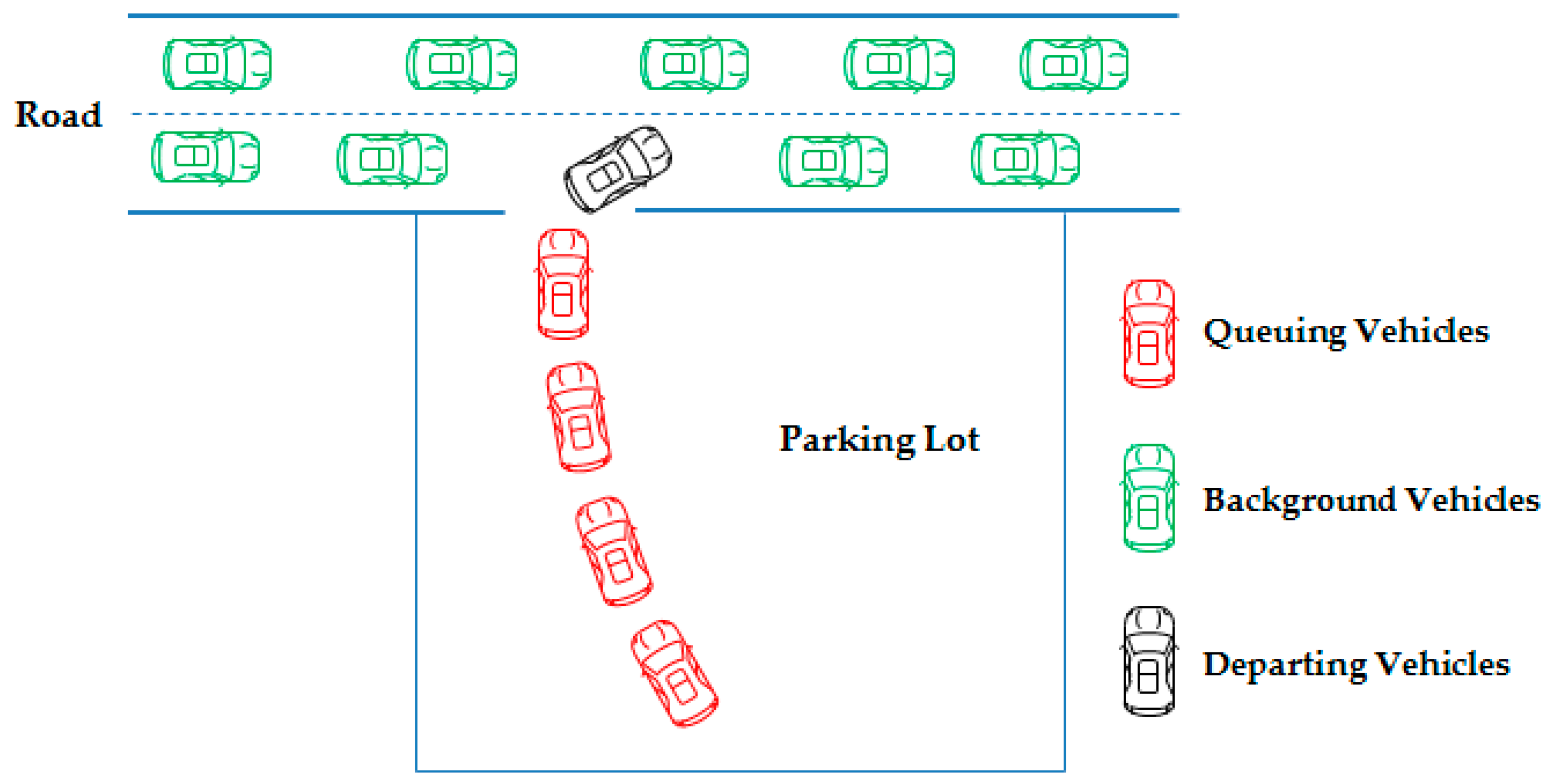

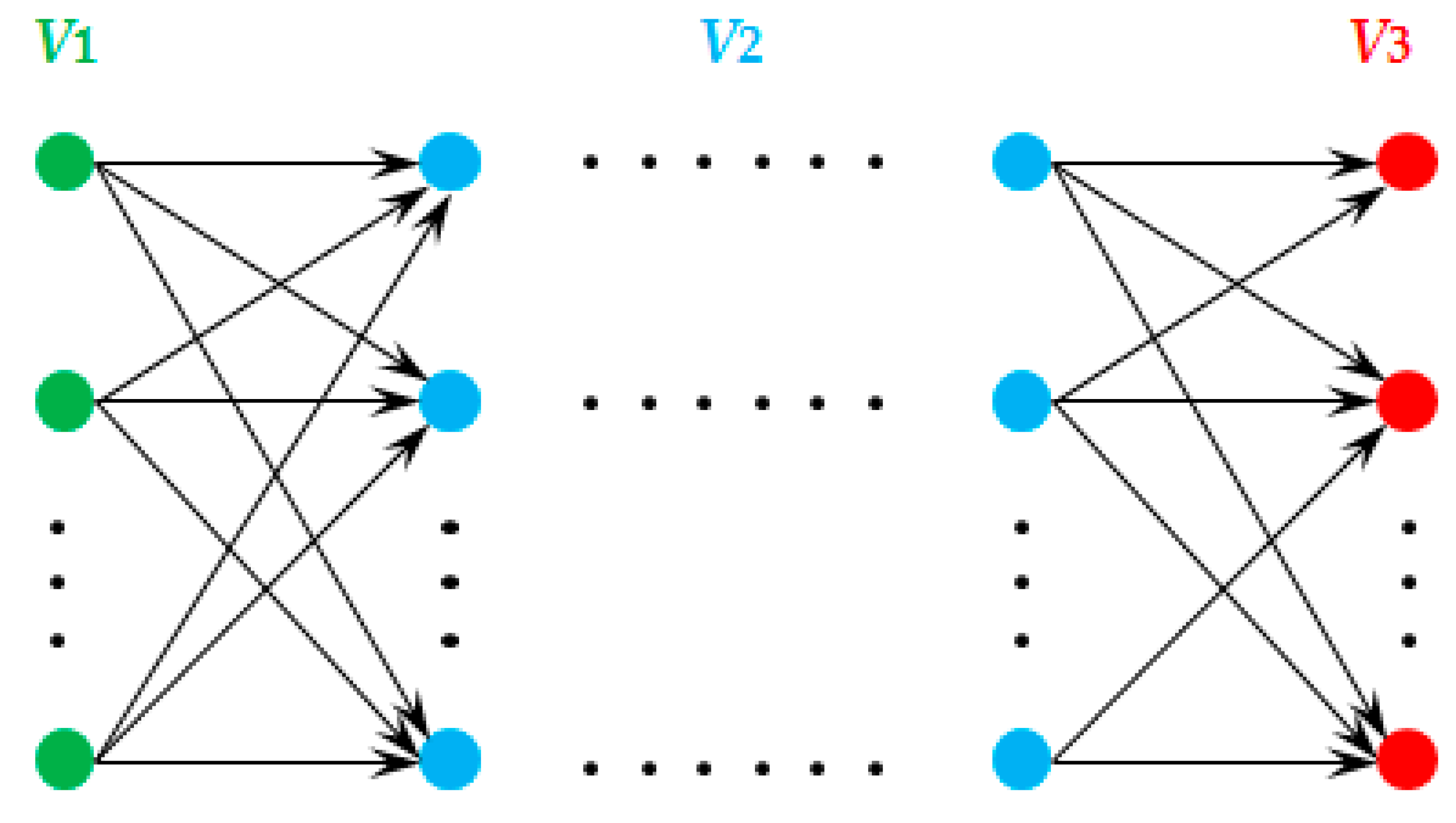
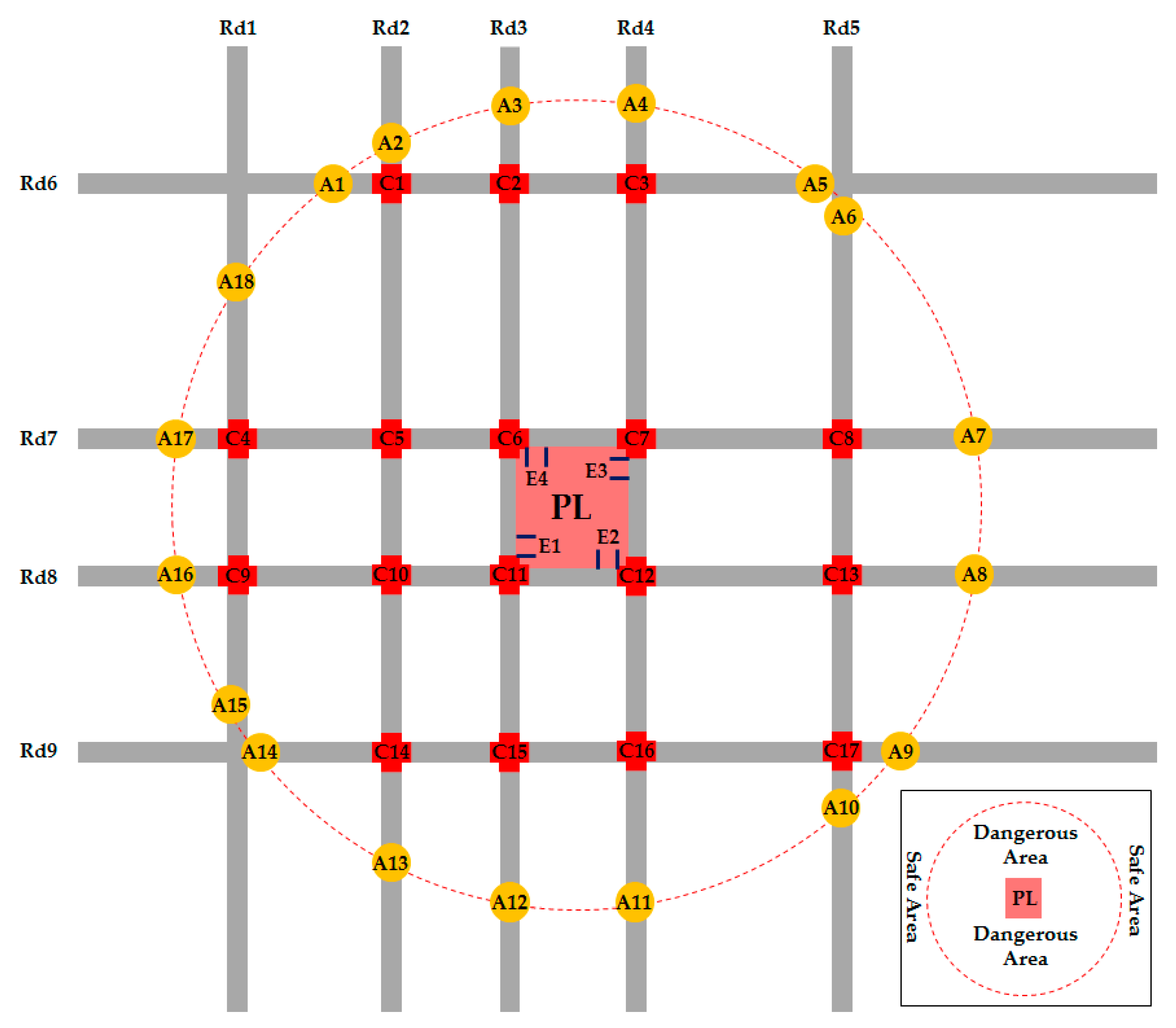


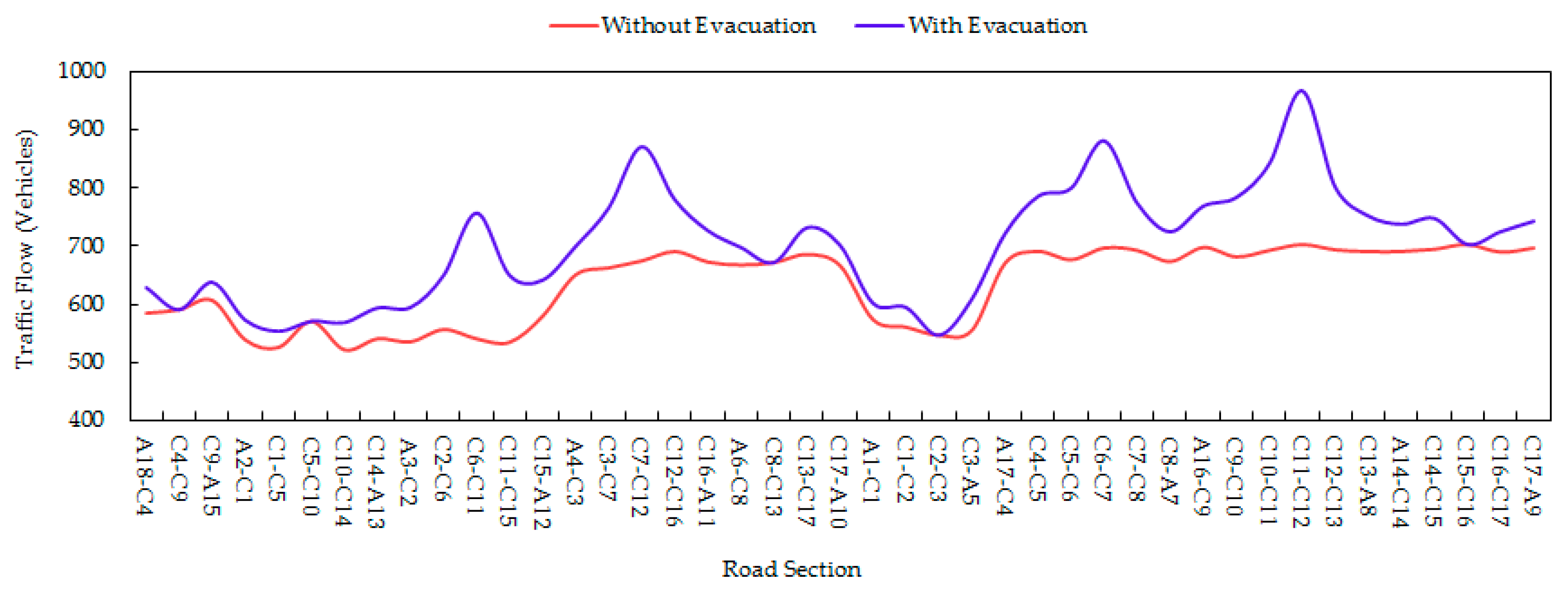
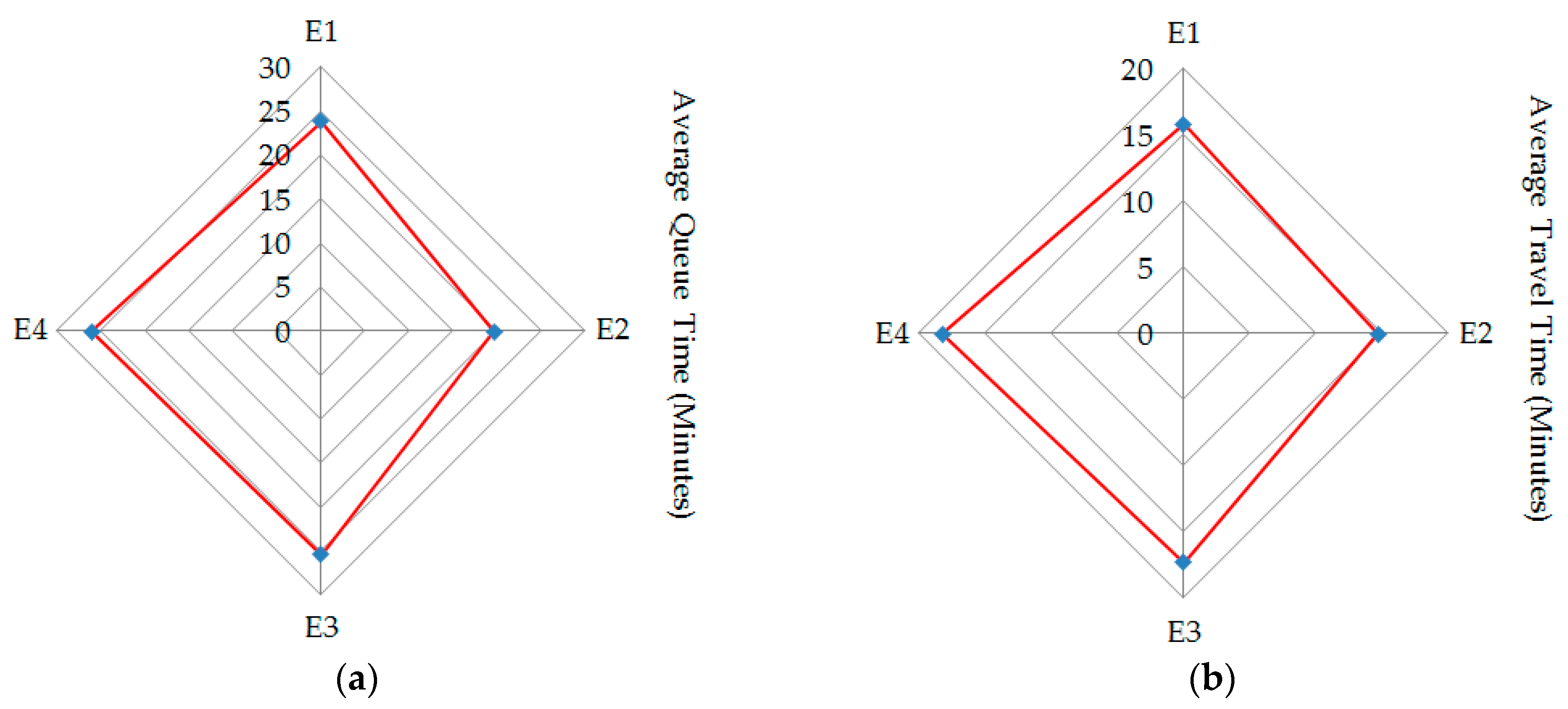
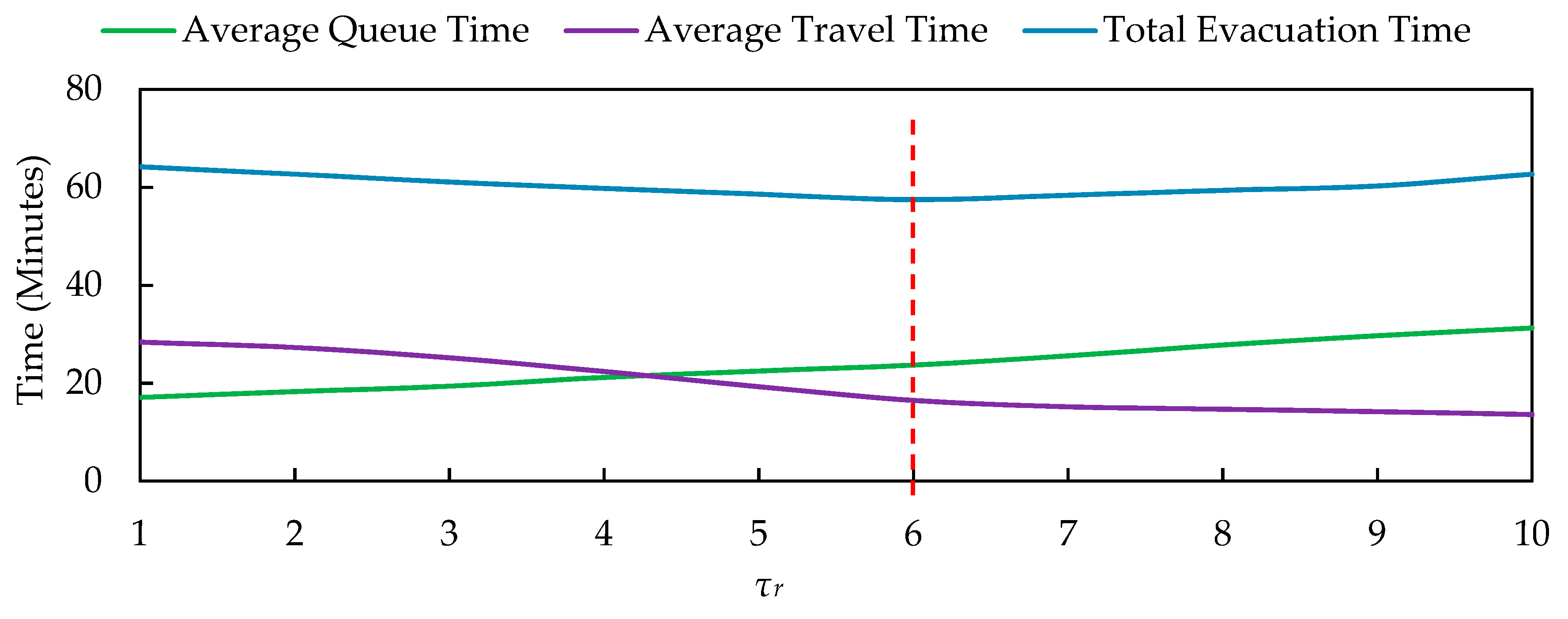
| Intersection | Signal Cycle Time (s) | Green Time Ratio | Intersection | Signal Cycle Time (s) | Green Time Ratio |
|---|---|---|---|---|---|
| C1 | 145 | 0.42 | C10 | 125 | 0.45 |
| C2 | 140 | 0.42 | C11 | 106 | 0.46 |
| C3 | 130 | 0.48 | C12 | 144 | 0.41 |
| C4 | 138 | 0.50 | C13 | 138 | 0.43 |
| C5 | 140 | 0.41 | C14 | 125 | 0.46 |
| C6 | 135 | 0.45 | C15 | 125 | 0.46 |
| C7 | 120 | 0.45 | C16 | 142 | 0.37 |
| C8 | 118 | 0.48 | C17 | 135 | 0.34 |
| C9 | 122 | 0.50 |
| Parameters | Value | Parameters | Value | Parameters | Value |
|---|---|---|---|---|---|
| 3 s | 2.82 | 30 | |||
| 6 s | 0.65 | 0.5 | |||
| 80 km/h | 70 | 0.5 | |||
| 0.48 | 20 | 0.2 |
| Original Node | Destination Node | Route | Route ID | Total Vehicles Evacuated | Length (km) |
|---|---|---|---|---|---|
| E1 | A1 | E1-C6-C5-C1-A1 | R1 | 28 | 4.8 |
| A2 | E1-C6-C2-C1-A2 | R2 | 34 | 4.7 | |
| A3 | E1-C6-C2-A3 | R3 | 59 | 4.4 | |
| A17 | E1-C6-C5-C4-A17 | R4 | 51 | 3.3 | |
| A18 | E1-C6-C5-C4-A18 | R5 | 44 | 4.3 | |
| E2 | A12 | E2-C11-C15-A12 | R6 | 62 | 4.4 |
| A13 | E2-C11-C15-C14-A13 | R7 | 53 | 4.5 | |
| A14 | E2-C11-C10-C14-A14 | R8 | 47 | 4.4 | |
| A15 | E2-C11-C10-C9-A15 | R9 | 31 | 3.9 | |
| A16 | E2-C11-C10-C9-A16 | R10 | 71 | 3 | |
| E3 | A8 | E3-C12-C13-A8 | R11 | 61 | 4.2 |
| A9 | E3-C12-C13-C17-A9 | R12 | 46 | 5.1 | |
| A10 | E3-C12-C16-C17-A10 | R13 | 35 | 4.9 | |
| A11 | E3-C12-C16-A11 | R14 | 54 | 4.3 | |
| E4 | A4 | E4-C7-C3-A4 | R15 | 49 | 4.1 |
| A5 | E4-C7-C3-A5 | R16 | 54 | 5.4 | |
| A6 | E4-C7-C8-A6 | R17 | 30 | 5.3 | |
| A7 | E4-C7-C8-A7 | R18 | 51 | 4.1 |
© 2019 by the authors. Licensee MDPI, Basel, Switzerland. This article is an open access article distributed under the terms and conditions of the Creative Commons Attribution (CC BY) license (http://creativecommons.org/licenses/by/4.0/).
Share and Cite
Mao, X.; Yuan, C.; Gan, J.; Zhou, J. Optimal Evacuation Strategy for Parking Lots Considering the Dynamic Background Traffic Flows. Int. J. Environ. Res. Public Health 2019, 16, 2194. https://doi.org/10.3390/ijerph16122194
Mao X, Yuan C, Gan J, Zhou J. Optimal Evacuation Strategy for Parking Lots Considering the Dynamic Background Traffic Flows. International Journal of Environmental Research and Public Health. 2019; 16(12):2194. https://doi.org/10.3390/ijerph16122194
Chicago/Turabian StyleMao, Xinhua, Changwei Yuan, Jiahua Gan, and Jibiao Zhou. 2019. "Optimal Evacuation Strategy for Parking Lots Considering the Dynamic Background Traffic Flows" International Journal of Environmental Research and Public Health 16, no. 12: 2194. https://doi.org/10.3390/ijerph16122194
APA StyleMao, X., Yuan, C., Gan, J., & Zhou, J. (2019). Optimal Evacuation Strategy for Parking Lots Considering the Dynamic Background Traffic Flows. International Journal of Environmental Research and Public Health, 16(12), 2194. https://doi.org/10.3390/ijerph16122194





